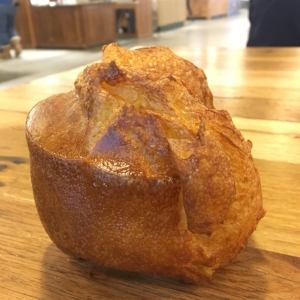A Pile of Popovers

What's not to love about having a large pile of popovers sitting in front of you?
Popovers courtesy of The Popover Lady at the Boston Public Market.
I'm lucky to have a great spot like the Boston Public Market just down the street from my office. The market opened in 2015 and has space for over 30 vendors, with a variety of fresh, local food that evolves continually with the seasons. It's becoming one of my favorite spots to hide out and get work done because it has that perfect level of hustle and bustle to keep you stimulated, but not so much that you can't focus on your own work.
Like the Trillium Garden at the Substation featured in my previous post, the space occupied by the Public Market had been vacant for over 12 years. The Boston Public Market Association raised $13 million to transform the space, and I'm happy they did.
The market is a bright, open space filled with sensory stimulation of every kind, something I find particularly valuable during the cold, dreary Boston winter. Look one way you'll see a stand filled with rainbow-colored carrots, perky radishes and piles of purple and green kale; look another and you'll smell made-to-order pasta dishes and mouthwatering sandwiches. Head around the corner and you're greeted by locally-spun yarns and freshly picked flowers.
Simply put, the Boston Public is a delight and it was where I found this week's lovely pastries.
Serious About Popovers
I was excited to find a new vendor in the market on a recent trip: The Popover Lady. The Popover Lady (Naomi Cannistraci) is not messing around when it comes to her product. The stand offers customers a very focused selection of products: large popovers, small popovers and adorable mini pies. I decided to go for it and bought myself both a regular popover and a cinnamon and sugar drenched popover (both large, obviously). Each one was big enough to fill my cupped hands with light, buttery goodness.
In the past I've always had plain popovers, so I was excited about the cinnamon and sugar saturated version. And while it was tasty, I have to say it was almost too much for me. I found myself wanting to go back again and again to the simple goodness of its simpler brother. I guess the lesson here is don't mess with a good thing.
I discovered when making this purchase that The Popover Lady also offers popover breakfast sandwiches. I'll definitely be trying those out on a future trip!
I love looking at popovers from all the different angles. No two views are the same, just as not two popovers are the same.
Part of what I think is fun about popovers is their shape. The popover is named for its characteristic rising, and there's no way to predict what the finished popover will look like. No two popovers ever look the same. I guess they are the snowflakes of the culinary world in that way—endless variation, but always delicious.
Humble Origins
Popovers are the American version of a much more commonly eaten British dish—Yorkshire Pudding (which is not, in fact, any sort of pudding as we Americans know pudding...confusing, right?). Yorkshire pudding, however, is usually cooked as one large pastry, rather than the smaller, muffin-sized pastries typical of popovers, and is commonly eaten with meat dishes like a Sunday roast.
This dish dates back to the 17th century, when flour became a more common ingredient in British households used to make cakes and (British) puddings. Cooks began making "dripping puddings" similar to the modern Yorkshire pudding from the drippings collected as a large piece of meat cooked. These puddings were then often served as a first course with gravy as a way to fill diners' stomachs so they wouldn't eat quite so much of the more expensive meat course that followed.
When American settlers came from Britain, they of course brought these culinary traditions with them. Like the language and culture they accompanied, these recipes changed and adapted in this new space. According to author Evan Jones in his book American Food, we have the modern American popover courtesy of some enterprising Mainers:
"Settlers from Maine who founded Portland, Oregon, Americanized the pudding from Yorkshire by cooking the batter in custard cups lubricated with drippings from the roasting beef (or sometimes pork); another modification was the use of garlic, and, frequently, herbs. The result is called Portland popover pudding: individual balloons of crusty meat-flavored pastry."
The name "popover" first appears in print in American correspondence from 1850 and the first recipe appeared in the cookbook Practical Cooking and Dinner Giving by Mary Newton Henderson published in 1876.
My brother Paul with his own pile of homemade popovers.
I'm always curious to find culinary "cousins" across different cultures. The humble Yorkshire pudding has plenty of these in addition to the American popover, including:
- The French gougère
- The Japanese takoyaki (a puffed batter dumpling filled with octopus)
- The Danish æbleskiver
What Makes a Popover Pop?
Popovers are made from a thin batter composed of milk, eggs and flour similar to a pancake batter. Unlike pancake batter, however, popover batter is usually whipped up in a blender to activate the gluten in the flour. This process creates the bubbles that grown and stretch with cooking to give the dish its characteristic pop. Popover batter also has a higher proportion of liquid, which turns to steam as it cooks. As steam builds up on the inside, it rises and looks for a way out, bringing the walls of the popover with it.
When done right, the result is hollow, airy, buttery golden goodness. What could be better than that?
------------
Feeling inspired? Try making your own popovers with this popover tutorial from the Kitchn.
You can also visit Jordan Pond House restaurant in Acadia National Park for their iconic popovers, including a ice cream sundae version!




